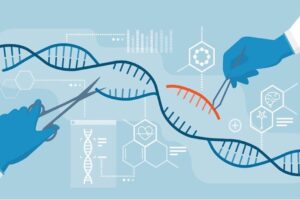
An intricate view of the intertwined helices of DNA. (Source: Wikimedia Commons, KES47)
The development of high-tech machinery within the field of biology has led to the development of remarkable technologies – from the first DNA sequencing machines to more modern innovations such as DNA sensors. DNA sensors – fragments of DNA capable of binding to and detecting viral particles – are likely to be integral for detecting and controlling the spread of infectious diseases in the future. Even beyond infectious disease, the applications of this new technology range from cell signaling to diagnostics and it has quickly become a cornerstone of proteomic research (Schneider, 2018). These sensors bind to foreign DNA to activate downstream immune signaling pathways and alert neighboring cells by eliciting the expression of antiviral cytokines
Scientists from the University of Illinois, Chicago and the National University of La Plata, Argentina have innovated a novel DNA sensor device that can not only detect when a specific virus is present in human cells, but also whether that virus is infectious (ScienceDaily, 2021). Such a technology is a vital tool for preventing disease spread, as knowing whether a positive case of viral infection is actually contagious will help guide environmental disinfection methods.
PCR tests, the ‘gold standard’ for viral detection, are not well suited for determining whether a virus is actually contagious and likely to be passed on to others, while the DNA sensor technology is able to make this distinction. This is problematic for tracking and containing outbreaks. Additionally, the virus’s infectivity has low correspondence with the amount of virus. For example, an individual could have minimal detectable viral RNA, but that individual could still be extremely contagious (“COVID-19 CT values”, 2020). On the other hand, an individual might still have a high viral load (at the back end of an infection), yet not be infectious any longer. Thus, not knowing enough about viral infectivity can lead to both additional spreading of disease, and quarantining of individuals that is more extensive than necessary (ScienceDaily, 2021)
There is an existing technology to determine the infectivity of a viral infection known as a plaque assay, but these tests need a unique form of preparation and the results for these tests can take several days to acquire. The University of Illinois / University of La Plata research team, however, has developed their DNA sensor technology such that it can produce results on viral infectivity in less than thirty minutes. The technology was tested on human adenovirus, an emerging waterborne viral pathogen of international concern. However, by tweaking the structure of the DNA sensors, it would be possible to use the technology for detecting many different types of viruses, including SARS-CoV-2, the coronavirus causing the current global pandemic (ScienceDaily, 2021)
Moving forward, the research team aims to improve the selectivity of the sensor as well as test it with different detection methods such as viral nucleic acid detection using quantitative polymerase chain reaction (qPCR) has become the reference standard method due to its high sensitivity(Orcid.org, September 2021). Moreover, the improvement and testing of this technology can yield a clearer understanding of infection mechanisms as well as different types of infections such as noroviruses and enteroviruses. Ultimately, broad use of this technology with prevalent viruses affecting the international community today offers immense hope to combat current and future infections that could plague our society.
References
Covid-19 CT values – government of New Jersey. (n.d.). Retrieved January 9, 2022, from https://www.nj.gov/health/cd/documents/topics/NCOV/APHL-COVID19-Ct-Values.pdf
Peinetti, A. S., Lake, R. J., Cong, W., Cooper, L., Wu, Y., Ma, Y., Pawel, G. T., Toimil-Molares, M. E., Trautmann, C., Rong, L., Mariñas, B., Azzaroni, O., & Lu, Y. (2021). Direct detection of human adenovirus or SARS-CoV-2 with ability to inform infectivity using DNA aptamer-nanopore sensors. Science advances, 7(39), eabh2848. https://doi.org/10.1126/sciadv.abh2848
ScienceDaily. (2021, September 22). DNA sensor quickly determines whether viruses are infectious. ScienceDaily. Retrieved December 20, 2021, from https://www.sciencedaily.com/releases/2021/09/210922155847.htm
Schneider, A.-K., & Niemeyer, C. M. (2018, December 4). DNA surface technology: From gene sensors to Integrated Systems for life and Materials Sciences. Wiley Online Library. Retrieved December 20, 2021, from https://onlinelibrary.wiley.com/doi/abs/10.1002/anie.201811713
Related Posts
Insect Microbiome Gives Hope for New Antibiotic Discovery
Figure 1: Actinobacteria were isolated from 56% of the insect...
Read MoreWhite Noise Can Improve Memory, Boost Attention, and Reduce Stress
Source: Ivan Samkov Music has evolved over the years, with...
Read MoreAre We Driving Our Dogs Sick Through Our Urban Lifestyles?
Figure 1: Allergic disorders in humans and dogs are associated...
Read MoreHow Genetic Engineering Can Responsibly Revolutionize Healthcare Treatment
Source: iStock At just 3 months old, Victoria Gray was...
Read MoreThe Immunological and Physiological Effects of SARS-COV-2 on the Human Body
Figure 1: The representation of cellular activity of SARS-COV-2 as...
Read MoreKrithika Nathamuni






